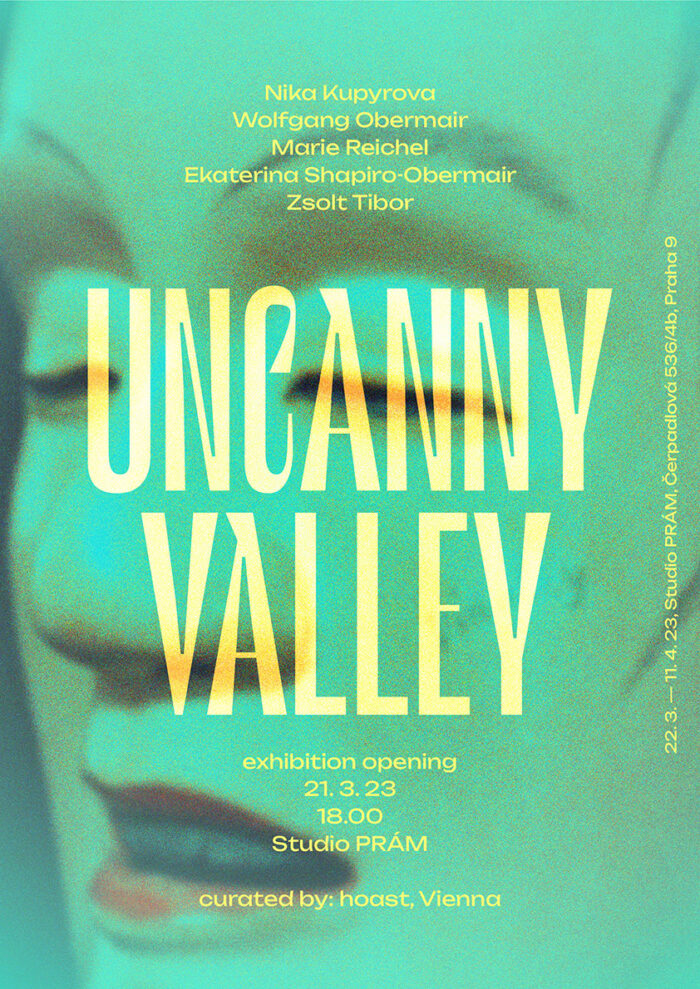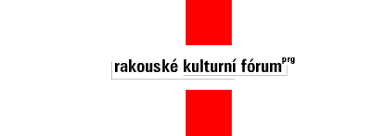
with
Nika Kupyrova
Wolfgang Obermair
Marie Reichel
Ekaterina Shapiro-Obermair
Zsolt Tibor
Exhibition Opening
21.03.23
18.00
Studio PRÁM
curated by: hoast, Vienna
Location:
Studio PRÁM, Čerpadlová 536/4b, Praha 9
http://pramstudio.cz/
+420 730 576 699 ǀ info@pramstudio.cz
Open by appointment
On view: 22.03. — 11.04.23
Photography: -> Anna Pleslová


















Only a few minutes away from the point where the Vienna Valley reaches its end, lies an independent exhibition space hoast. The curatorial collective hoast which has been running the space for over six years has now prepared a group exhibition for Studio Prám in Prague featuring artists Nika Kupyrova, Wolfgang Obermair, Marie Reichel, Ekaterina Shapiro-Obermair and Zsolt Tibor, who all are affiliated with the Viennese space. The inspiration for the exhibition Uncanny valley draws from the theory of the same name by Mori Masahiro from the 1970s. The theory suggests when robots or animated characters approach a high degree of resemblance to humans in their looks and actions, they can trigger an eerie and unsettling sensation in people, known as the uncanny feeling. The exhibition focuses on the discrepancy between reality and its representation and the feeling that it awakens in the viewer. This feeling evoked by non-living entities is decisive for the exhibition Uncanny Valley as the selected artworks try to emulate that strange, unsettling feeling for which the German language has the seemingly confounding term unheimlichkeit.
Unheimlichkeit is a particularly challenging German term for translating due to its ambivalent nature. The word formed by the root heim (home) in the cognate with the ending –lich implies something familiar, and intimate, but also hidden, concealed, and enigmatic. However, when negated with the prefix un-, the word takes on a whole new meaning. The very meaning of the term unheimlich has been explored by thinkers such as Sigmund Freud, Ernst Jentsch, and many others. What is indisputable, however, is that the feeling of unheimlichkeit is closely linked to the feeling of anxiety. Nika Kupyrova, Wolfgang Obermair, Marie Reichel, Ekaterina Shapiro-Obermair, and Zsolt Tibor explore this specific feeling in their exhibited works, each stimulating it in a unique way although having a similar way in depicting something that is both familiar and elusive. The sculptures and paintings on display are contours of realities that are close yet so far.
Eye-catching are the in space distributed monumental metal sculptures by Nika Kupyrova hung on greenish ropes which fall to the ground. These sculptures cut out of sheet steel are depicting silhouettes of orchid blooms deprived of any spatial depth or distinction in color. The shape awakens in the spectators the feeling of something familiar, known. The sculptures, however, do not represent only one species of this plant, but various ones, which differ significantly in shape. So much that viewers are confused as to whether what they are seeing are actually still orchid flowers. The loss of the possibility of naming what surrounds us creates a feeling of anxiety. This is magnified by the large format of the sculptures.
Is what you see really what you suppose? This question is also posed by the sculptures of artist Wolfgang Obermair. In the case of surrealistic-looking assemblage sculptures, the viewer is first captivated by the play with the balance between the individual parts of the objects. A closer look at the sculpture reveals that the used materials, seemingly clearly recognizable, not something one should think about, are not what they seem to be. This fact causes a feeling of uncertainty and throws us off balance. The one thing that was the link between us and reality has blown in the air.
The objects, materials, and even body parts that were once familiar may change through inner processes their appearance and become estranged, as is playfully shown by sculptures of Marie Reichel. That the change can occur from within is performed by the material itself. The black deformed appearing objects are made from clay which by the reduction of oxygen in the process of burning changes its appearance and traits. These ceramic objects may be used as vessels or tableware however these objects resemble also very old toes, so old that the nails grew so long that they started to curl and deform. Therefore, upon the pedestals are positioned objects that can be considered unworthy of being placed there or on display. The pedestals, in turn, are aptly made from old artworks from Marie Reichel that the artist decided not to exhibit for a long time, so they should have remained hidden. What awakens a sense of anxiety more than the public display of something that has become alienated from us, or even something of which we are ashamed?
As we move through the exhibition, the graphic works of Ekaterina Shapiro-Obermair accompany us along the way. The first piece reminds us of a night sky illuminated by a full moon. Whereby it brings about a certain feeling of unease ingrained in human subconsciousness. During this time, we become more alert glancing over our shoulders, wary of what may be lurking in the shadows. This feeling is further intensified by the subsequent pieces on display. In them, human forms are reduced to mere patterns and geometric shapes, leaving us uncertain whether the shapes represent faces. This sensation accompanies us as we observe other artworks. We find ourselves constantly drawn back to these images on the wall since they evoke the unsettling feeling of us being watched.
The representation of the mundane is also characteristic of Zsolt Tibor‘s works, yet the depicted ordinary objects that surround our day-to-day lives are abstracted into mere silhouettes. The artist himself says that he tries to depersonalize the depicted objects as much as possible. Looking closely at the large-scale collage-like drawings, there are certain motifs that keep recurring. This opens up an enigmatic approach for the audience, looking for objects that they are able to decipher. The oscillation between the familiar and the unfamiliar can create a sense of unease.
The exhibition UNCANNY VALLEY invites the viewer to move in the environment of the contradiction between the familiar and the unknown, thereby experience the unease that arises from this liminal space. The displayed artworks remind us that aesthetic experience is not necessarily associated with pleasant feelings, but with feelings of fear, anxiety, and unease as was already described by Kant, Schiller, and Lyotard.
Text: Anežka Jabùrková
Supported by:

